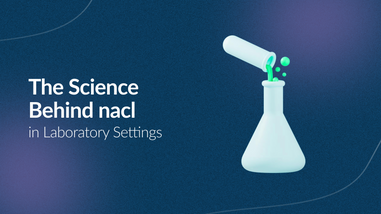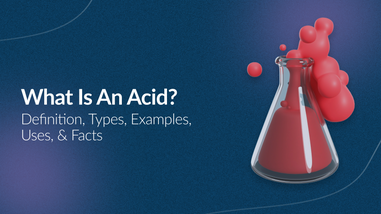- No products in the cart.
That sharp taste when you bite a lemon, the fizz in your favorite soda, even the digestive juices churning in your stomach right now, all of these involve acids. These substances are far more common in our daily lives than most people realize.
From the vinegar in your salad dressing to the battery under your car's hood, acids are working behind the scenes in countless ways.
But what exactly makes something an acid? Why do chemists get so excited about these hydrogen-donating compounds? This guide breaks down everything you need to know about acids, their definition, types, characteristics, and practical uses.
Key Takeaways:
-
Acids are substances that release hydrogen ions (H⁺) in water.
-
They have distinct properties, like a sour taste and reactivity with metals.
-
Acids are classified by their strength, source, and ability to donate protons.
-
Common acids include citric acid in fruits and acetic acid in vinegar.
-
Strong acids completely dissociate in water, while weak acids only partially dissociate.
-
Acids play crucial roles in food preservation, cleaning, and industrial processes.
-
The pH scale measures how acidic or basic a solution is, with acids falling below 7.
What Are Acids?
Acids are substances that release hydrogen ions (H⁺) when you dissolve them in water. These hydrogen ions or protons are what give acids their characteristic properties and chemical behavior. Think of acids as generous donors constantly looking to give away their hydrogen.
Scientists have actually developed three different ways to define "What are acids?".
While these definitions vary in complexity, they all center on the same idea: acids interact with hydrogen atoms, making them chemically reactive.
Acid Classification
Chemists love organizing things, and acids are no exception. There are several useful ways to classify acids based on their properties and structure.
Classification by Source
-
Organic Acids come from living things like plants and animals. These acids contain carbon in their molecular structure and are generally the ones you'll find in food. They tend to be weaker and safer to consume than their mineral cousins.
-
Mineral Acids (also called inorganic acids) come from minerals and don't contain carbon. Sulfuric acid, hydrochloric acid, and nitric acid fall into this category. These are strong, corrosive acids used in industry and laboratories.
Classification by Oxygen Presence
-
Oxyacids contain oxygen atoms along with hydrogen and other elements. Common examples include sulfuric acid (H₂SO₄), nitric acid (HNO₃), and phosphoric acid (H₃PO₄).
-
Hydracids (or binary acids) consist of hydrogen bonded directly to another nonmetal element without any oxygen. They're written in the simple H-A form. Hydrochloric acid (HCl) and hydrofluoric acid (HF) are typical hydracids.
Classification by Strength
-
Strong Acids completely break apart in water, releasing all their hydrogen ions. There are actually only six common strong acids: hydrochloric acid (HCl), sulfuric acid (H₂SO₄), nitric acid (HNO₃), hydrobromic acid (HBr), hydroiodic acid (HI), and perchloric acid (HClO₄). These powerful substances typically measure between 0-3 on the pH scale.
-
Weak Acids only partially dissociate in water, holding onto some of their hydrogen ions. Most organic acids fall into this category, including acetic acid and citric acid. They usually register between 4 to 6 on the pH scale and are much safer to handle.
Fact: the world's strongest acid isn't on either list. Fluoroantimonic acid (HSbF₆) is considered a "superacid" that's incredibly more powerful than even concentrated sulfuric acid.
Classification by Concentration
-
Concentrated acids contain a high percentage of actual acid dissolved in solution. These are more dangerous and reactive.
-
Dilute acids have a low percentage of acid in solution. The vinegar in your kitchen is dilute acetic acid, much safer than the concentrated version used in laboratories.
Classification by Basicity
-
Monobasic acids have one hydrogen ion (like HCl)
-
Dibasic acids have two hydrogen ions (like H₂SO₄)
-
Tribasic acids have three hydrogen ions (like phosphoric acid, H₃PO₄)
Need high-quality acids for laboratory or industrial work?
See our full collection of chemicals
Key Characteristics Of Acids
Acids are defined by a set of distinct characteristics that determine how they interact in different environments. These properties make acids essential in everyday products, industrial applications, and biological processes.

Common Acids: 7 Types You Encounter Daily
Acids are a part of our daily lives, often in forms we don’t even recognize. From the tangy taste of citrus to the fizz in sodas, acids play a key role in food, cleaning, and more. In this section, we’ll explore seven common acids you encounter regularly, highlighting their uses and impact in everyday activities.

Also, read:
-
Ethyl Alcohol vs. Isopropyl Alcohol for Cleaning Electronics in the Lab
-
Beakers vs. Graduated Cylinders: The Pros and Cons of Common Lab Glassware
Industrial Acids: The Big Four
Some acids are so important to manufacturing that economies depend on them.
-
Sulfuric Acid (H₂SO₄) is the most produced chemical in the world. Car batteries contain sulfuric acid, and it's essential for making fertilizers, refining petroleum, and treating wastewater. This oily, highly corrosive liquid is a workhorse of modern industry.
-
Nitric Acid (HNO₃) is crucial for producing fertilizers and explosives. The food industry uses it to sterilize canned goods by killing bacteria. It's powerful enough to dissolve most metals, though gold and platinum resist it.
-
Hydrochloric Acid (HCl) cleans steel in a process called "pickling," controls pH in various processes, and helps produce corn syrup. You might know its commercial name: muriatic acid, sold at hardware stores for cleaning concrete and adjusting pool chemistry.
-
Hydrofluoric Acid (HF) is a weak acid by chemical definition, but it's incredibly dangerous. It etches glass, cleans metals, and is essential for producing semiconductors, refrigerants, and pharmaceuticals. It even helps make high-octane gasoline. Handle with extreme care: it can dissolve glass and penetrate skin.
Understanding pH: The Acid-Base Scale
The pH scale gives us a simple way to measure how acidic or basic something is. pH stands for "potential of hydrogen" or "power of hydrogen". Both names refer to hydrogen ion concentration.
The scale runs from 0 to 14:
-
0-6: Acidic (lower numbers = stronger acids)
-
7: Neutral (pure water)
-
8-14: Basic or alkaline
For example, attery acid measures around 0-1, lemon juice sits at 2-3, tomatoes register at 4-5, and milk lands near 6. Pure water at 7 is neutral. Above 7, we enter base territory: seawater at 8, baking soda around 9, and drain cleaner at 13-14.
You can test pH using simple litmus paper. It is a universal indicator solution that creates a color spectrum, or a precise electronic pH meter. According to the U.S. Geological Survey, pH testing is fundamental to water quality monitoring worldwide.
Safety And Handling: What You Need To Know
Many acids can cause serious burns or injuries, so understanding safe handling is essential.
-
Household acids: Always read product labels and follow instructions. Ensure good ventilation when using acidic cleaners. Never mix acids with other chemicals, especially bleach. Store products securely away from children.
-
Laboratory and industrial acids: Proper personal protective equipment is mandatory: chemical-resistant gloves, safety goggles, and lab coats. Always add acid to water, never water to acid. Adding water to concentrated acid can cause violent splashing and boiling.
-
First aid for acid exposure: Immediately flush affected areas with large amounts of water for at least 15 minutes. Remove contaminated clothing. Seek medical attention for any significant exposure.
Facts About Acids
Here are some surprising acid facts:
-
Your stomach acid is strong enough to dissolve razor blades, yet your stomach lining regenerates so quickly that it protects you completely.
-
Ants spray formic acid as a defense mechanism. That burning sensation from an ant bite? That's acid.
-
Acid rain forms when industrial emissions combine with atmospheric water, damaging buildings and ecosystems.
-
The strongest acid ever made (fluoroantimonic acid) is 10 quintillion times stronger than pure sulfuric acid.
-
Aqua regia, a mixture of acids, earned its name "royal water" because it can dissolve gold, the king of metals.
Acids are essential to chemistry, biology, industry, and everyday life. From the citric acid in your juice to the sulfuric acid in car batteries, acids play a vital role. They release hydrogen ions and have a pH below 7, making them highly reactive. Understanding acids helps you navigate both scientific and practical applications safely and effectively.
At Lab Pro Inc., we specialize in providing premium chemicals, lab equipment, and supplies to facilities worldwide.
Our Vendor Managed Inventory (VMI), which helps optimize your supply chain through tailored inventory solutions, ensures you always have the supplies you need without overstocking. Our 20+ years of experience enable us to support your laboratory needs with precision and care.
Looking for high-quality lab supplies or equipment?
Explore our full range of products here
FAQs
What are acids doing at the molecular level when they dissolve in water?
When acids dissolve in water, their molecules release hydrogen ions (H⁺) into the solution and form hydronium ions (H₃O⁺). This shift in ion balance affects reaction rates, electrical conductivity, and the behavior of the solution
What are acids in terms of their role in buffers and pH stability?
Acids play a key role in buffer systems, where a weak acid and its conjugate base help maintain the pH of a solution when small amounts of acid or base are added. Understanding what acids are in buffering systems is essential for applications ranging from blood chemistry to chemical manufacturing.
What are acids that are polyprotic, and why does this matter?
Some acids can donate more than one hydrogen ion (H⁺) per molecule; these are called polyprotic acids (e.g., Phosphoric acid). Recognizing what acids are in this category is important because each successive hydrogen release has a different dissociation strength and pH impact.
What are acids used for in advanced industrial processes beyond the common ones?
Beyond basic cleaning and etching, industrial acids serve in catalyst regeneration, waste treatment, extraction of metals, and high‑precision manufacturing. Understanding what acids are in these advanced contexts helps highlight their critical role across sectors.
What are acids in the context of environmental chemistry, and how are they monitored?
Acids in the environment can arise from natural sources or human activity (industry, combustion). Monitoring what acids are helps in addressing acid rain, soil acidification, and water treatment.












































